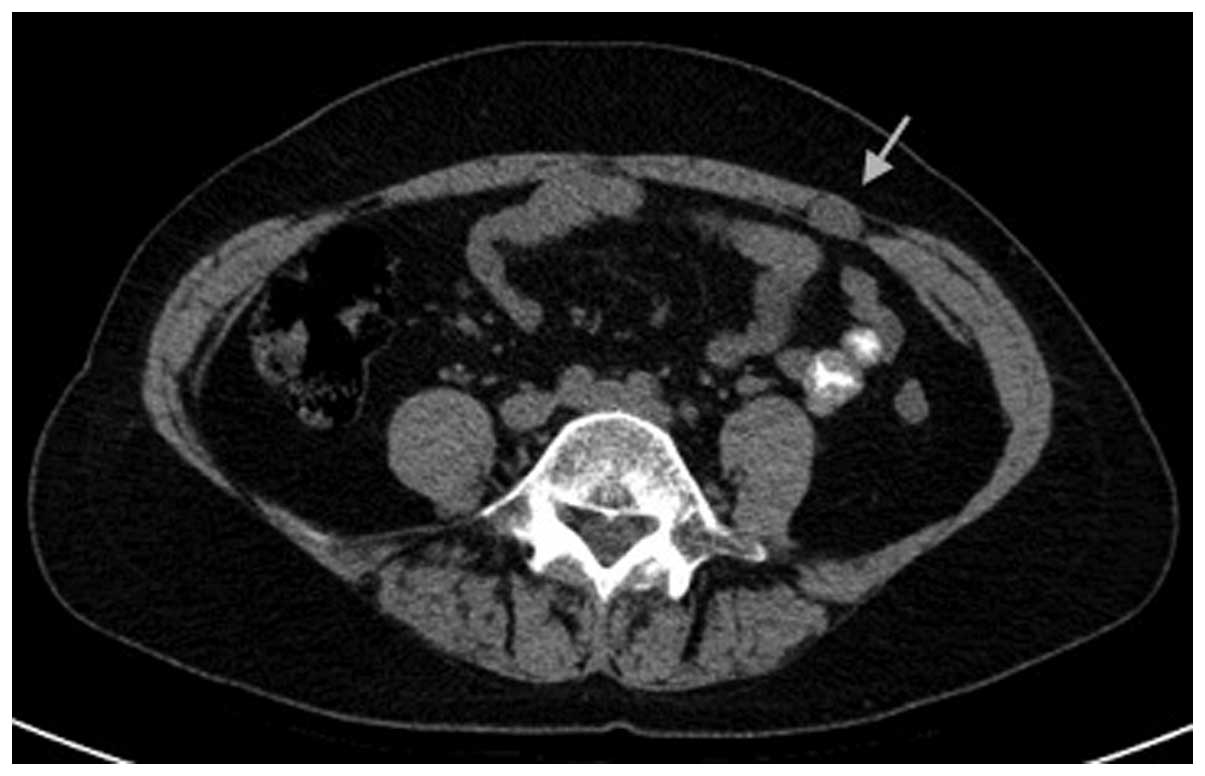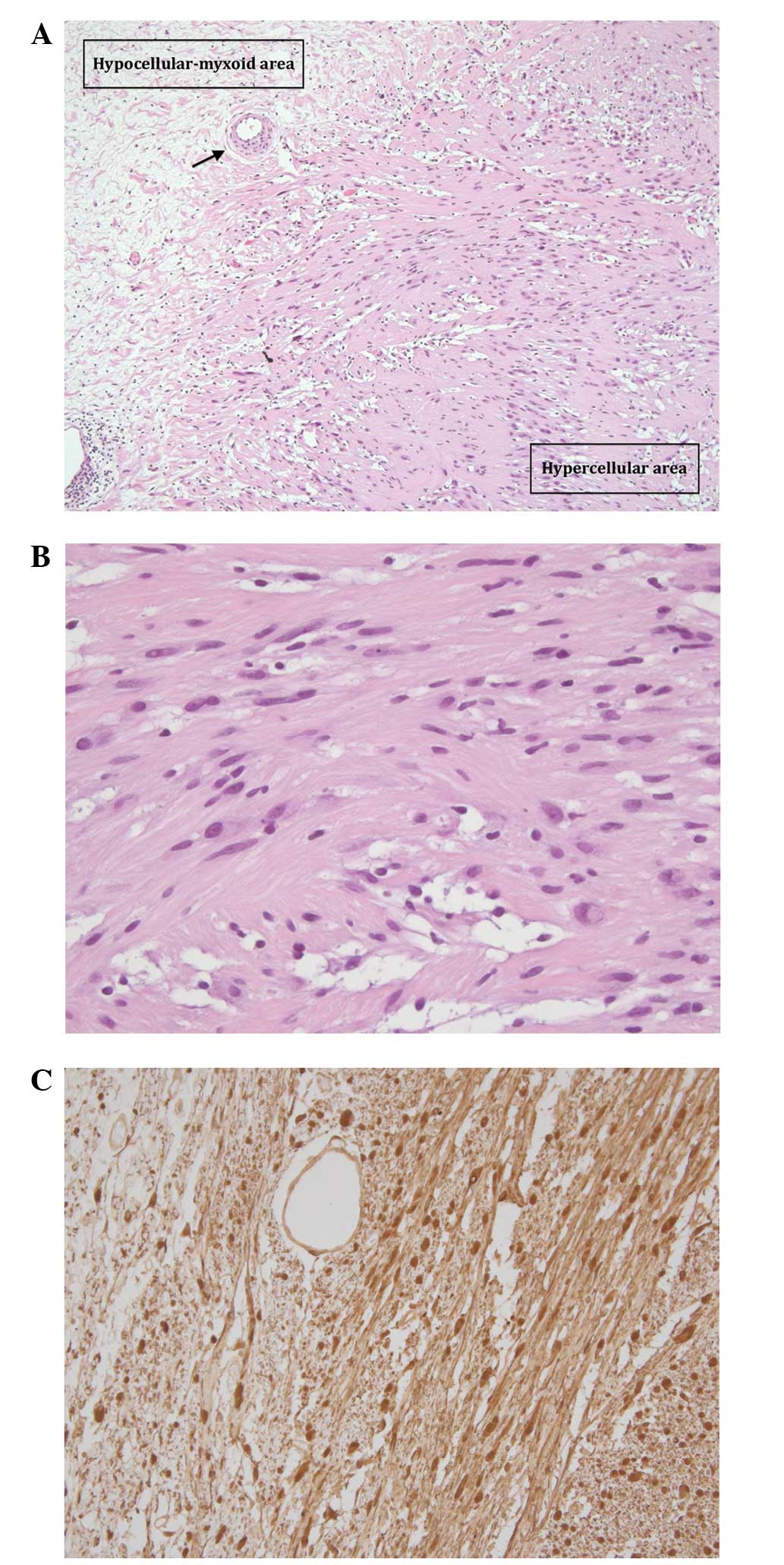Symptomatic schwannoma of the abdominal wall: A case report and review of the literature
- Authors:
- Published online on: January 12, 2015 https://doi.org/10.3892/ol.2015.2866
- Pages: 1095-1098
-
Copyright: © Balzarotti et al. This is an open access article distributed under the terms of Creative Commons Attribution License.
Abstract
Introduction
Schwannoma (neurinoma or neurilemmoma) is a rare, benign tumor, composed exclusively of Schwann cells, that arises from the nerve sheath, as opposed to neurofibrome consisting of different cell types that constitute the nerve. Schwannoma is the most common tumor of the nerves and the incidence in adults is ~5% (1). It is common in neurocutaneous diseases as neurofibromatosis I; in neurofibromatosis II, schwannoma involves typically eighth nerves. It is an encapsulated lesion without an infiltrative behaviour; the lesion pushes the nerve laterally, assuming an eccentric shape, usually <3 cm in diameter. In this sense, malignant transformation is rare and growth is slow. In some locations, schwannoma can reach a considerable size, with degenerative features such as cyst, fibrosis and calcification (2). In the majority of cases, the tumor is identified incidentally and involves the limbs, trunk, head and neck. Infrequently, it can arise in any part of the body. Surgical excision is the treatment of choice. The decision whether to operate depends on the degree of the symptomatology and the location of the lesion. The balance between the relief of pain and the potential neurological deficit is a key point in the decision-making. Due to the low risk of relapse and the exceptional malignant transformation, enucleation is a surgical option (3). Partial excision can be considered in order to avoid neurological sequelae.
To the best of our knowledge, the present study is the third reported case of a schwannoma located in the abdominal wall, and the first symptomatic case (4,5). Written informed consent was obtained from the patient.
Case Report
A 57-year-old woman presented to the surgical outpatient department due to well-localized parietal pain in the left lower quadrant. The onset of pain occurred three years prior to presentation, without apparent cause and in the absence of other symptoms. The pain was extremely localized, 6–7 cm inferiorly and laterally to the umbilicus, and was not associated with movement, position or particular events such as oral feeding and stress. Overall, the symptomatology increased over time, in terms of frequency and intensity of the abdominal pain. On physical examination, the abdomen was not painful and no mass was identified or suspected. All routine laboratory tests were normal. During the first year of symptoms, a gastroenterological outpatient consultation was performed and a colonoscopy procedure did not reveal any lesions or abnormalities. During the same consultation, an ultrasound examination was performed, notably revealing a well-defined cystic lesion, 1.6 cm in diameter, located in the muscular layer of the left-lower quadrant of the parietal wall. The nodule was not painful upon the administration of pressure. Due to the persistence of the symptoms, one year later an abdominal computed tomography (CT) scan was performed. In a preliminary analysis, no lesions were identified in the peritoneal cavity or abdominal wall, and no parietal defects were found. Three years subsequent to the onset of the symptoms, a novel analysis and review of the radiological images revealed the presence of a small parietal nodule. In order to confirm and verify the possible alteration in the tumor, a novel CT scan was performed.
The CT scans were performed on a 16-channel multislice unit (Brilliance 16p; Philips, Amsterdam, Netherlands) and on a 256-channel multislice unit (iCT256; Philips) prior to and following the administration of intravenous (IV) contrast media with a two-year interval between the two examinations. A 17×11 mm mass was identified in the abdominal wall, on the left edge of the left rectus anterior muscle (Fig. 1). The mass exhibited a homogeneous soft mass density on basal CT, with a regular oval shape. The IV administration of contrast media for dynamic CT revealed a modest, homogeneous enhancement of the lesion (Fig. 2). No difference was identified between the first and second examinations.
The suspected diagnosis was of a benign schwannoma of the anterior abdominal wall. The most notable indication of the cause-effect association between the lesion and the parietal abdominal pain was the considerable topographic coincidence. Presented with this clear association, an indication for surgical removal was discussed with the patient and decided by mutual agreement.
A pre-operative ultrasound examination (Logiq E9 Ultrasound System; GE Healthcare Life Sciences, Chalfont, UK) confirmed the size and shape of the mass, which was hypoechoic with certain internal linear hyperechoic structures (Fig. 3).
The patient underwent surgery under general anesthesia, which was performed using a direct anterior approach. By making an incision into the anterior fascia of the left rectus abdominis muscle, the lesion was immediately identified at the lateral edge of the muscle (Fig. 4). Notably, a small parietal nerve entered and exited the nodule in an eccentric manner. The tumor was completely resected.
Macroscopically, the nodule was 2 cm in diameter, rounded and of tense-elastic consistency, exhibiting a white color in the center of the lesion and possessing a peripheral region of myxoid appearance (Fig. 5).
Microscopically, the lesion demonstrated an alternation of hypercellular and hypocellular areas, each comprising spindle cells without significant atypia. In the hypocellular area, foci of myxoid differentiation were also present. The tumor cells were revealed to strongly and diffusely express the S-100 protein by immunohistochemistry (Fig. 6), confirming the diagnosis of benign schwannoma. The post-operative course was uneventful and the symptoms ceased completely. A one-year follow-up appointment did not reveal any relapse of the symptoms.
Discussion
Schwannomas are benign tumors of the Schwann cells in the neural sheath of cranial and peripheral nerves. The lesions usually involve the extremities, but can also be found in the head and neck, trunk, pelvis, retroperitoneum, mediastinum and gastrointestinal tract. However, the tumors are extremely uncommon in parenchymatous organs, such as the liver and pancreas (6). There is a female predominance and schwannoma typically occurs between the ages of 20–50 years old (7,8).
In numerous cases the schwannoma is asymptomatic and is identified incidentally upon physical examination or imaging. Occasionally, the tumors are symptomatic due to the compression of surrounding large nerves (9).
To the best of our knowledge, only two cases of benign schwannoma located in the abdominal wall have been reported in the medical literature at present. In the first case (4), a healthy 64-year-old female underwent a whole body CT scan, which revealed an incidental mass of 6 cm in the right iliac fossa. The second study (5) reported the case of a 29-year-old female who presented with a painless lump in the left-upper abdomen, which had been gradually increasing in size over 10 months. The tumor was 6 cm in diameter and, notably, the tumor was located between the rectus abdominis muscle and the lateral abdominal muscle, which is identical to the tumor location in the present patient. In the two cases, a histopathological diagnosis of benign ancient schwannoma was made.
Ancient schwannoma is a sub-type of schwannoma characterized by degenerative changes that are observed under microscopy (10). These changes are the result of long-term progression (11). In the present case, the symptomatic behavior of the lesion, which was characterized by persistent pain of the abdominal wall, may explain the early diagnosis of a schwannoma that was small in size and, accordingly, lacked degenerative changes.
As in the present patient, the identification of a nerve entering and exiting a mass is pathognomonic for a peripheral nerve sheath tumor and the eccentric association with the nerve is considered to be pathognomonic for a schwannoma rather then a neurofibroma (12,13).
To conclude, the definitive treatment for benign schwannoma is surgical removal. The prognosis of these lesions is good (14), recurrence is unusual and malignant transformation is extremely rare (15). To the best of our knowledge, the present study reports the first case of symptomatic schwannoma of the abdominal wall. A lesion located in the abdominal wall should be considered among the rare causes of unexplained abdominal pain.
References
|
Forthman CL and Blazar PE: Nerve tumors of the hand and upper extremity. Hand Clin. 20:233–242. 2004. View Article : Google Scholar : PubMed/NCBI | |
|
Abernathey CD, Onofrio BM, Scheithauer B, et al: Surgical management of giant sacral schwannomas. J Neurosurg. 65:286–295. 1986. View Article : Google Scholar : PubMed/NCBI | |
|
Li Q, Gao C, Juzi JT and Hao X: Analysis of 82 cases of retroperitoneal schwannoma. ANZ J Surg. 77:237–240. 2007. View Article : Google Scholar : PubMed/NCBI | |
|
Bhatia RK, Banerjea A, Ram M and Lovett BE: Benign ancient schwannoma of the abdominal wall: an unwanted birthday present. BMC Surg. 10:12010. View Article : Google Scholar : PubMed/NCBI | |
|
Mishra A, Hamadto M, Azzabi M and Elfagieh M: Abdominal wall schwannoma: case report and review of the literature. Case Rep Radiol. 2013:4568632013.PubMed/NCBI | |
|
Hayashi M, Takeshita A, Yamamoto K and Tanigawa N: Primary hepatic benign schwannoma. World J Gastrointest Surg. 4:73–78. 2012. View Article : Google Scholar : PubMed/NCBI | |
|
White W, Shiu MH, Rosenblum MK, Erlandson RA and Woodruff JM: Cellular schwannoma. A clinicopathologic study of 57 patients and 58 tumors. Cancer. 66:1266–1275. 1990. View Article : Google Scholar : PubMed/NCBI | |
|
Theodosopoulos T, Stafyla VK, Tsiantoula P, et al: Special problems encountering surgical management of large retroperitoneal schwannomas. World J Surg Oncol. 6:1072008. View Article : Google Scholar : PubMed/NCBI | |
|
Hide IG, Baudouin CJ, Murray SA and Malcolm AJ: Giant ancient schwannoma of the pelvis. Skeletal Radiol. 29:538–542. 2000. View Article : Google Scholar : PubMed/NCBI | |
|
Dodd LG, Marom EM, Dash RC, Matthews MR and McLendon RE: Fine-needle aspiration cytology of “ancient” schwannoma. Diagn Cytopathol. 20:307–311. 1999. View Article : Google Scholar : PubMed/NCBI | |
|
Argenyi ZB, Balogh K and Abraham AA: Degenerative (“ancient”) changes in benign cutaneous schwannoma. A light microscopic, histochemical and immunohistochemical study. J Cutan Pathol. 20:148–153. 1993. View Article : Google Scholar : PubMed/NCBI | |
|
Beaman FD, Kransdorf MJ and Menke DM: Schwannoma: radiologic-pathologic correlation. Radiographics. 24:1477–1481. 2004. View Article : Google Scholar : PubMed/NCBI | |
|
Tsai WC, Chiou HJ, Chou YH, et al: Differentiation between schwannomas and neurofibromas in the extremities and superficial body: the role of high-resolution and color Doppler ultrasonography. J Ultrasound Med. 27:161–166. 2008.PubMed/NCBI | |
|
Eizinger FM and Weiss SW: Benign tumors of peripheral nerves. Soft Tissue Tumors. Third edition. Mosby; St. Louis, MO: pp. 829–842. 1995 | |
|
Akin M, Bozkirli B, Leventoglu S, et al: Liver schwannoma incidentally discovered in a patient with breast cancer. Bratisl Lek Listy. 110:298–300. 2009.PubMed/NCBI |















